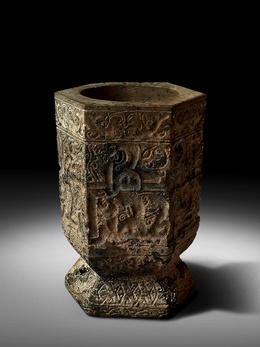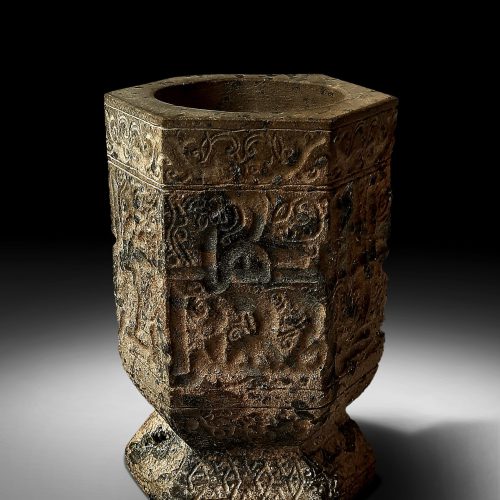Footnotes: | Pincering is a technique widely found throughout the Islamic world in the mediaeval period. A range of pincered glass vessels of various dates has been recovered at Fustat, including cups and vases. The type of decoration is usually geometric, including roundels, rosettes, triangles and dots, but occasionally figurative, as in the case of a cup from Egypt where a series of small birds have been pincered around the body (Lamm, C.J.:Mittelalterliche Gläser und Steinschnittarbeiten aus dem Nahen Osten, 2 vols, Berlin, 1929-30, Tafel 19,10 as quoted in Contadini, A.: Fatimid Art at the Victoria and Albert Museum, London, 1998, p.96). Further examples of the same technique have also been excavated at Nishapur (Kröger, Jens: Nishapur: Glass of the Early Islamic Period, New York 1995, no.141, pp.100-102). There is a bowl of a similar rich blue colour with a pincered design in the Museum fr Islamische, Kunst, Berlin, no.I.1539 (Seipel, W.: Schätze der Kalifen, Islamische Kunst zur Fatimidenzeit, Vienna, 1999, pp.199-200, no. 182) which was purchased in Cairo in 1905. It has been attributed to 9th/10th century Egypt. Another bowl with very similar six-petal rosettes is in the Victoria and Albert Museum, no. C.157-1936 (Contadini, A.: op.cit., p.101, pl.42) which has also been attributed to 10th-century Egypt or Syria. In contrast to the two Fatimid examples quoted above, the Nishapur jug discussed by Kröger has decoration on a more comparable scale to the present bowl but is colourless. One discovery however helps us to make the distinction between the Fatimid and the Nishapur possible origins. In 1973 the remains of a boat carrying glass vessels was discovered off the coast of Turkey. Now known as the Serçe Limani shipwreck, it is precisely dateable to around 1025, the date of the latest coins and glass weights on board. The shape of the present bowl, its pincered decoration, and the method of finishing the rim can be very closely paralleled in a bowl which was found on this wreck (Jenkins, Marylin: ‘Islamic Glass, a brief history’, Metropolitan Museum of Art Bulletin, Vol XLIV, no.2, Fall 1996, fig.p.8). While the precise decoration differs, the Serçe Limani bowl has an overall lozenge lattice, the other factors, coupled with the almost identical colour of the Berlin pincered bowl, make an attribution to Fatimid Egypt sure. |
|---|






